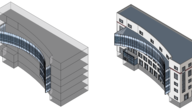You are here
Improving the performance of our existing building stock is incredibly important. New construction only replaces or adds a few percent per year at most to the world's existing stock of buildings. Existing buildings can often be improved at far lower cost than would be required to raze and replace them.
According to the Intergovernmental Panel on Climate Change (IPCC), “over the whole building stock, the largest portion of carbon savings by 2030 is in retrofitting existing buildings and replacing energy using equipment” and energy savings for 50-75% can be achieved in commercial buildings who make smart use of energy efficiency measures.
The generalized process of ecodesign described on this site applies to both new construction and remodeling or retrofitting existing buildings. One of the big differences between the two is that during the Predesign phase of remodels and retrofits, the existing building structure needs to be studied in detail and will introduce a whole set of design constraints. The same design strategies will apply to both, but designers will not have as much latitude to reshape existing buildings.
When working with an existing building, you’ll want to understand the energy use of the building and its thermal performance, existing equipment and controls schedules, occupancy patterns, lighting and other systems. It is often difficult to get detailed information on constructions and other things that cannot be readily observed. Tools like sensors, sub-meters, and infrared cameras can help.
Getting a good as-built model of the building is also important, and often difficult. Reality capture tools like smart cameras (GPS, level and accelerometer) and laser scanners can help capture the geometry of the building.
Links and References
- A great book by Stewart Brand that explains how buildings evolve over time.
- Chapter 6 discusses residential and commercial buildings


